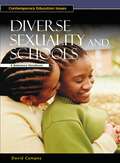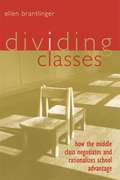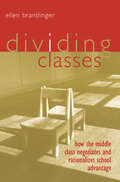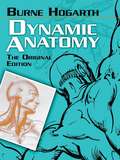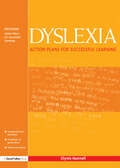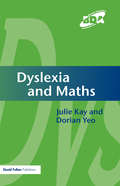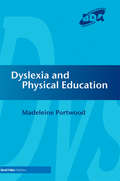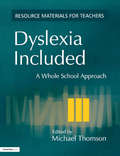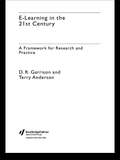- Table View
- List View
Distance Education: What Works Well
by Michael CorryDon&’t start from scratch! Learn what works-and what doesn&’t-in providing education to off-campus students! This unique compilation presents practical advice on how to set up distance learning programs that effectively serve the needs of students who don&’t have access to the campus. The book examines issues surrounding development, implementation, teacher training, time management, and other important aspects of distance education. Distance Education: What Works Well brings you lessons garnered from real-life experiences at several institutions to help you explore the pros and cons of distance education-and what it takes to implement a distance program that really works. In the first half of Distance Education: What Works Well you&’ll examine: the development of a digital high school-from the early stages through "rookie camp" experiences practical recommendations on how to design successful online high school programs what has worked well-and what has not-in terms of distance education in the rural K-12 environment the successful and not-so-successful aspects of an innovative distance education project that encourages collaboration between high schools and middle schools The second half of this informative book presents practical advice to help you set up distance learning programs that make the most of available technology. You&’ll learn: how to train faculty to effectively use distance education techniques the importance of student-teacher and student-student interaction in a distance education setting-and how to build active online communities that keep students and faculty in touch the roles and functions of moderators in online education-and the skills they need to be effective six effective tactics designed to optimize online time how to decide whether distance education is the right choice for you
Diverse Sexuality and Schools: A Reference Handbook (Contemporary Education Issues)
by David CamposAn overview of the gay, lesbian, bisexual, and transgender (GLBT) students in our schools—what they endure, their special needs, and the programs and groups that support them.Diverse Sexuality and Schools: A Reference Handbook is an eye-opening report on gay, lesbian, bisexual, and transgender youth in our schools—the isolation they feel, the hostilities they face, their unique developmental and emotional needs, and the innovative ways schools, communities, and organizations are working to support them.Author David Campos offers a compelling, often harrowing, tour of the lives of GLBT students, including what researchers have learned over the past half-century and what the schools, the courts, and the government are doing to keep them safe regardless of their sexual orientation. But perhaps the book's greatest impact comes from the way Campos gives voice to this often neglected population, providing a forum for these students' painful testimonies of harassment, violence, and despair.
Dividing Classes: How the Middle Class Negotiates and Rationalizes School Advantage
by Ellen BrantlingerIn this study of the school system of an Indiana town, Ellen Brantlinger studies educational expectations within segments of the middle class that have fairly high levels of attainment. Building on her findings, she examines the relationship between class structure and educational success. This book asserts the need to look beyond poor peoples' values and aspirations--and rather to consider the values of dominant groups--to explain class stratification and educational outcomes.
Dividing Classes: How the Middle Class Negotiates and Rationalizes School Advantage
by Ellen BrantlingerIn this study of the school system of an Indiana town, Ellen Brantlinger studies educational expectations within segments of the middle class that have fairly high levels of attainment. Building on her findings, she examines the relationship between class structure and educational success. This book asserts the need to look beyond poor peoples' values and aspirations--and rather to consider the values of dominant groups--to explain class stratification and educational outcomes.
Drafting and Assessing Poetry: A Guide for Teachers (PDF)
by Sue Dymoke`This excellent book provides the reader with comprehensive coverage of all aspect of poetry teaching. The book does more than inform us - it inspires profound reflection on the best ways to support poetry writing and draws us into the debate about assessment-driven curriculum' - School Librarian. `A must for trainee teachers and English departments' - Booktrusted News. `Drafting and Assessing Poetry is thoroughly researched and shows how attitudes towards teaching of poetry and indeed the place of poetry on the syllabus, has changed with political fashion over the years, but more importantly, Sue Dymoke shows how a handful of contemporary poets go about drafting their work and sees this process as an essential tool in the classroom, advocating that students should keep drafting notebooks, just like real writers. Getting students, or indeed members of writing groups, to understand that one draft of a poem may not be the final or best work they can produce will never be a problem again!' - Writing in Education. `Sue Dymoke's book is a much needed antidote to the ubiquitous guides to poetry analysis. This book is well worth reading for its clarity and wealth of ideas' - Bethan Marshall, TES Teacher Magazine. `Every English department should buy this remarkably comprehensive book. Inspiring approaches for teaching children to write poetry are clearly described. Sue Dymoke draws upon her extensive experience as a poet, English teacher and researcher to explore the place of writing poetry in English lessons and examinations. Her unique insights into both the writing and teaching of poetry should prove invaluable to English teachers' - Dr Mark Pike, Lecturer in English Education and Head of PGCE English, University of Leeds. `It is a useful book: a theoretical text, but with a practical focus, which makes it very readable and interesting, to teachers of young people particularly, but also, to teachers of adults and indeed in parts to poetry writers themselves, particularly those interested in working in schools, or simply curious about the general process of drafting and evaluating poetry' - County Lit, Nottinghamshire County Council Literature Newsletter. Drafting and Assessing Poetry offers a range of teaching strategies for developing students' poetry writing skills, and guidance about assessment approaches. Critical commentaries combine with illustrations of successful classroom practice to consider this essential but under-explored aspect of English teaching. Based on theory but with a practical dimension, the book engages readers in current critical debates about poetry teaching and its place in an assessment-driven curriculum. This book is for reflective practitioners, including trainee teachers, who want to develop their understanding of poetry teaching and to gain insights, which will inform classroom practice. It will also be useful for literacy co-ordinators, teacher educators and other advisory staff in the field of English teaching.
Drafting and Assessing Poetry: A Guide for Teachers
by Sue Dymoke`This excellent book provides the reader with comprehensive coverage of all aspect of poetry teaching. The book does more than inform us - it inspires profound reflection on the best ways it support poetry writing and draws us into the debate about assessment-driven curriculum' - School Librarian `A must for trainee teachers and English departments' - Booktrusted News `Drafting and Assessing Poetry is thoroughly researched and shows how attitudes towards teaching of poetry and indeed the place of poetry on the syllabus, has changed with political fashion over the years, but more importantly, Sue Dymoke shows how a handful of contemporary poets go about drafting their work and sees this process as an essential tool in the classroom, advocating that students should keep drafting notebooks, just like real writers. Getting students, or indeed members of writing groups, to understand that one draft of a poem may not be the final or best work they can produce will never be a problem again!' - Writing in Education `Sue Dymoke's book is a much needed antidote to the ubiquitous guides to poetry analysis. . . . This book is well worth reading for its clarity and wealth of ideas' - Bethan Marshall, TES Teacher Magazine `Every English department should buy this remarkably comprehensive book. Inspiring approaches for teaching children to write poetry are clearly described. Sue Dymoke draws upon her extensive experience as a poet, English teacher and researcher to explore the place of writing poetry in English lessons and examinations. Her unique insights into both the writing and teaching of poetry should prove invaluable to English teachers' - Dr Mark Pike, Lecturer in English Education and Head of PGCE English, University of Leeds `It is a useful book: a theoretical text, but with a practical focus, which makes it very readable and interesting, to teachers of young people particularly, but also, to teachers of adults and indeed in parts to poetry writers themselves, particularly those interested in working in schools, or simply curious about the general process of drafting and evaluating poetry' - County Lit, Nottinghamshire County Council Literature Newsletter Drafting and Assessing Poetry offers a range of teaching strategies for developing students' poetry writing skills, and guidance about assessment approaches. Critical commentaries combine with illustrations of successful classroom practice to consider this essential but under-explored aspect of English teaching. Based on theory but with a practical dimension, the book engages readers in current critical debates about poetry teaching and its place in an assessment- driven curriculum. This book is for reflective practitioners, including trainee teachers, who want to develop their understanding of poetry teaching and to gain insights, which will inform classroom practice. It will also be useful for literacy co-ordinators, teacher educators and other advisory staff in the field of English teaching.
Drafting and Assessing Poetry: A Guide for Teachers
by Sue Dymoke`This excellent book provides the reader with comprehensive coverage of all aspect of poetry teaching. The book does more than inform us - it inspires profound reflection on the best ways it support poetry writing and draws us into the debate about assessment-driven curriculum' - School Librarian `A must for trainee teachers and English departments' - Booktrusted News `Drafting and Assessing Poetry is thoroughly researched and shows how attitudes towards teaching of poetry and indeed the place of poetry on the syllabus, has changed with political fashion over the years, but more importantly, Sue Dymoke shows how a handful of contemporary poets go about drafting their work and sees this process as an essential tool in the classroom, advocating that students should keep drafting notebooks, just like real writers. Getting students, or indeed members of writing groups, to understand that one draft of a poem may not be the final or best work they can produce will never be a problem again!' - Writing in Education `Sue Dymoke's book is a much needed antidote to the ubiquitous guides to poetry analysis…. This book is well worth reading for its clarity and wealth of ideas' - Bethan Marshall, TES Teacher Magazine `Every English department should buy this remarkably comprehensive book. Inspiring approaches for teaching children to write poetry are clearly described. Sue Dymoke draws upon her extensive experience as a poet, English teacher and researcher to explore the place of writing poetry in English lessons and examinations. Her unique insights into both the writing and teaching of poetry should prove invaluable to English teachers' - Dr Mark Pike, Lecturer in English Education and Head of PGCE English, University of Leeds `It is a useful book: a theoretical text, but with a practical focus, which makes it very readable and interesting, to teachers of young people particularly, but also, to teachers of adults and indeed in parts to poetry writers themselves, particularly those interested in working in schools, or simply curious about the general process of drafting and evaluating poetry' - County Lit, Nottinghamshire County Council Literature Newsletter Drafting and Assessing Poetry offers a range of teaching strategies for developing students' poetry writing skills, and guidance about assessment approaches. Critical commentaries combine with illustrations of successful classroom practice to consider this essential but under-explored aspect of English teaching. Based on theory but with a practical dimension, the book engages readers in current critical debates about poetry teaching and its place in an assessment- driven curriculum. This book is for reflective practitioners, including trainee teachers, who want to develop their understanding of poetry teaching and to gain insights, which will inform classroom practice. It will also be useful for literacy co-ordinators, teacher educators and other advisory staff in the field of English teaching.
Drawing and Painting: Children and Visual Representation (PDF)
by Dr John Matthews`This book is a tremendous resource for any early years setting. It enables us and encourages us to explore the process of artistic development through a fresh and inclusive lens' - Nursery World `This book is a welcome update of an informative text describing the process of children's mark making as a visual, physical and interactive process urging us to consider how we as adults perceive and support young children's mark making activities both at home and school. John Matthews demonstrates the cognitive function of this early mark making in relation to general individual development' - Early Years `A thought-provoking and informative book, this is essential reading for anyone involved in the education of young children' - Times Educational Supplement - Teacher `Drawing and Painting is a fascinating and delightful read for tutors, practitioners and students and is highly recommended an essential text for early years courses at level 3 and above'- Under Five This book has been revised to reflect recent developments in early childhood education, in developmental psychology and in our understanding of children's development in the arts. The author shows how this new model of children's development in visual representation has important implications for education. The author examines children's development in visual expression and suggests how this development might be supported. The book takes issue with the inherited wisdom about children's development in visual representation. The traditional approach describes children's development in terms of supposed deficits in which children progress from `primitive' earlier stages to `superior' ones, until the `defects' in their representational thinking are overcome and they arrive at an endpoint of `visual realism'. This approach is the pervasive influence on curricular planning, in arts education and in early years education. The author explains recent different models of development in visual expression. Instead of measuring children's efforts against an adult paradigm, the new models identify the modes of representation used by children as consequences of children's own intentions, motivations and priorities. The writing is accessible and assumes no specialist knowledge of psychological theory, art, its history or interpretation. This book is essential reading for early childhood educators, at nursery and pre-school level, for other professionals who work with very young children and parents, as well as students and tutors on early years courses. This is a revised edition of Helping Children to Draw and Paint: Children and Visual Representation, originally published in 1994.
Drawing and Painting: Children and Visual Representation
by Dr John Matthews`This book is a tremendous resource for any early years setting. It enables us and encourages us to explore the process of artistic development through a fresh and inclusive lens' - Nursery World `This book is a welcome update of an informative text describing the process of children's mark making as a visual, physical and interactive process urging us to consider how we as adults perceive and support young children's mark making activities both at home and school. John Matthews demonstrates the cognitive function of this early mark making in relation to general individual development' - Early Years `A thought-provoking and informative book, this is essential reading for anyone involved in the education of young children' - Times Educational Supplement - Teacher `Drawing and Painting is a fascinating and delightful read for tutors, practitioners and students and is highly recommended an essential text for early years courses at level 3 and above'- Under Five This book has been revised to reflect recent developments in early childhood education, in developmental psychology and in our understanding of children's development in the arts. The author shows how this new model of children's development in visual representation has important implications for education. The author examines children's development in visual expression and suggests how this development might be supported. The book takes issue with the inherited wisdom about children's development in visual representation. The traditional approach describes children's development in terms of supposed deficits in which children progress from `primitive' earlier stages to `superior' ones, until the `defects' in their representational thinking are overcome and they arrive at an endpoint of `visual realism'. This approach is the pervasive influence on curricular planning, in arts education and in early years education. The author explains recent different models of development in visual expression. Instead of measuring children's efforts against an adult paradigm, the new models identify the modes of representation used by children as consequences of children's own intentions, motivations and priorities. The writing is accessible and assumes no specialist knowledge of psychological theory, art, its history or interpretation. This book is essential reading for early childhood educators, at nursery and pre-school level, for other professionals who work with very young children and parents, as well as students and tutors on early years courses. This is a revised edition of Helping Children to Draw and Paint: Children and Visual Representation, originally published in 1994.
Dynamic Anatomy: The Original Edition
by Burne HogarthHailed by teachers, students, and critics for fifty years, this manual presents both action studies and practical diagrams for portraying the human figure in motion and at rest. Anatomical details appear in pragmatic, generalized shapes that simplify identification and reproduction. More than 300 images complement the easy-to-follow text, which includes a valuable survey of art history and magnificent figure drawings by such masters as Michelangelo, Rembrandt, Rodin, and Picasso.Burne Hogarth, called "the Michelangelo of the comic strip," is best known for his long-running Tarzan cartoons and for helping found New York's School of Visual Arts. In this study of the human figure, he explains muscular and skeletal structure from the artist's point of view, rather than that of the medical anatomist. Hogarth extends beyond the factual elements of anatomy to emphasize the relationship of mass to movement. His guide will prove an indispensable companion to artists at all skill levels who wish to render the human figure accurately and artistically.
Dyslexia: Action Plans for Successful Learning
by Glynis HannellA clearly explained guide to helping pupils cope with their dyslexia, this book dispels common myths and includes:* Comprehensive coverage of dyslexia -what it is and what causes it* Action plans to help pupils overcome their difficulties with reading, writing, spelling and maths* Advice on how pupils with dyslexia can boost their memory, concentra
Dyslexia: Action Plans for Successful Learning
by Glynis HannellA clearly explained guide to helping pupils cope with their dyslexia, this book dispels common myths and includes:* Comprehensive coverage of dyslexia -what it is and what causes it* Action plans to help pupils overcome their difficulties with reading, writing, spelling and maths* Advice on how pupils with dyslexia can boost their memory, concentra
Dyslexia and Maths
by Julie Kay Dorian YeoThis concise text helps the reader to understand why dyslexics find maths difficult and offers practical ideas for supporting them most effectively. It explains which areas of maths dyslexics tend to have particular difficulty with, assesses current teaching philosophies and methods, describes a framework of general learning principles that allow dyslexics to make progress in maths, and outlines a number of specific and effective teaching recommendations. The book helps teachers at primary and secondary levels to better understand the maths performance of dyslexics and gives them an overview of the ways in which dyslexics can best be supported in all aspects of maths learning.
Dyslexia and Maths
by Julie Kay Dorian YeoThis concise text helps the reader to understand why dyslexics find maths difficult and offers practical ideas for supporting them most effectively. It explains which areas of maths dyslexics tend to have particular difficulty with, assesses current teaching philosophies and methods, describes a framework of general learning principles that allow dyslexics to make progress in maths, and outlines a number of specific and effective teaching recommendations. The book helps teachers at primary and secondary levels to better understand the maths performance of dyslexics and gives them an overview of the ways in which dyslexics can best be supported in all aspects of maths learning.
Dyslexia and Physical Education
by Madeleine PortwoodMuch research has focused on dyslexia and co-ordination. This book examines the literature and provides a framework to support pupils with dyslexia, not only during PE lessons but in less structured environments, for example during break time when pupils are likely to be involved in physical activities.
Dyslexia and Physical Education
by Madeleine PortwoodMuch research has focused on dyslexia and co-ordination. This book examines the literature and provides a framework to support pupils with dyslexia, not only during PE lessons but in less structured environments, for example during break time when pupils are likely to be involved in physical activities.
Dyslexia Included: A Whole School Approach
by Michael ThomsonThis practical book provides teachers with techniques and suggestions to help dyslexic pupils. Written by a team of experienced practitioners who work in a specialist school, it offers clear guidance and tried and tested strategies to help those who need support in this area. The book addresses reading and spelling difficulties and also other aspects of pupils' learning difficulties, including: accessing the curriculum; dyspraxia and motor development problems; learning mathematics; the use of ICT; developing phonological coding; and understanding dyslexics' behaviour. Teachers and teaching assistants working in specialist and mainstream primary and secondary schools should find the book useful. It is also relevant to those doing specialist courses in dyslexia.
Dyslexia Included: A Whole School Approach
by Michael ThomsonThis practical book provides teachers with techniques and suggestions to help dyslexic pupils. Written by a team of experienced practitioners who work in a specialist school, it offers clear guidance and tried and tested strategies to help those who need support in this area. The book addresses reading and spelling difficulties and also other aspects of pupils' learning difficulties, including: accessing the curriculum; dyspraxia and motor development problems; learning mathematics; the use of ICT; developing phonological coding; and understanding dyslexics' behaviour. Teachers and teaching assistants working in specialist and mainstream primary and secondary schools should find the book useful. It is also relevant to those doing specialist courses in dyslexia.
E-Learning in the 21st Century: A Framework for Research and Practice
by D. Randy GarrisonThere is currently a technological revolution taking place in higher education. The growth of e-learning is being described as explosive, unprecedented, and above all, disruptive. This timely and comprehensive book provides a coherent framework for understanding e-learning in higher education.The authors draw on their extensive research in the area to explore the technological, pedagogical and organisational implications of e-learning, and more importantly, they provide practical models for educators to use to realise the full potential of e-learning. A unique feature of the book is that the authors focus less on the ever-evolving technologies and more on the search for an understanding of these technologies from an educational perspective.This book will be invaluable for researchers, practitioners and senior administrators looking for guidance on how to successfully adopt e-learning in their institutions. It will also appeal to anyone with an interest in the impact of e-learning on higher education and society.
E-Learning in the 21st Century: A Framework for Research and Practice
by D. Randy GarrisonThere is currently a technological revolution taking place in higher education. The growth of e-learning is being described as explosive, unprecedented, and above all, disruptive. This timely and comprehensive book provides a coherent framework for understanding e-learning in higher education.The authors draw on their extensive research in the area to explore the technological, pedagogical and organisational implications of e-learning, and more importantly, they provide practical models for educators to use to realise the full potential of e-learning. A unique feature of the book is that the authors focus less on the ever-evolving technologies and more on the search for an understanding of these technologies from an educational perspective.This book will be invaluable for researchers, practitioners and senior administrators looking for guidance on how to successfully adopt e-learning in their institutions. It will also appeal to anyone with an interest in the impact of e-learning on higher education and society.
E Nesbit: Author Study Activities for Key Stage 2
by Helen BromleyThis innovative series is designed to help primary teachers plan focused sessions on the work of popular, well-loved and valued authors, both classic and contemporary. Each book contains a range of activities for use directly in the classroom, covering biographical information about the author; a review of the author's work and a summary of major themes in his/her key texts; key language features of the author; frameworks to help children analyze, evaluate and compare texts, and to develop personal opinions of authors' works; ideas for writing modeled on or developed from key texts; speaking and listening opportunities; drama and role play ideas; and references to video, CD-ROM, websites and ICT activities. Inside each book is a full-color pullout poster illustrating the work of the author, which also has a set of challenges for children on the back. First published in the 1900s, Edith Nesbit's classic stories - including tales about the Bastable family, Five Children and It, The Treasure Seekers and The Railway Children - are still very popular indeed. This book presents activities on which to build a study of E. Nesbit's work, including: developing philosophical discussions on a variety of topics; ideas for writing - both narrative and non-narrative; ways of encouraging children to analyze text through devising games for others to play; promoting research skills - including critical reflection on internet use; investigating changes in language; comparing televisual and written versions of text; and work on cross-curricular themes, including history and geography.
E Nesbit: Author Study Activities for Key Stage 2
by Helen BromleyThis innovative series is designed to help primary teachers plan focused sessions on the work of popular, well-loved and valued authors, both classic and contemporary. Each book contains a range of activities for use directly in the classroom, covering biographical information about the author; a review of the author's work and a summary of major themes in his/her key texts; key language features of the author; frameworks to help children analyze, evaluate and compare texts, and to develop personal opinions of authors' works; ideas for writing modeled on or developed from key texts; speaking and listening opportunities; drama and role play ideas; and references to video, CD-ROM, websites and ICT activities. Inside each book is a full-color pullout poster illustrating the work of the author, which also has a set of challenges for children on the back. First published in the 1900s, Edith Nesbit's classic stories - including tales about the Bastable family, Five Children and It, The Treasure Seekers and The Railway Children - are still very popular indeed. This book presents activities on which to build a study of E. Nesbit's work, including: developing philosophical discussions on a variety of topics; ideas for writing - both narrative and non-narrative; ways of encouraging children to analyze text through devising games for others to play; promoting research skills - including critical reflection on internet use; investigating changes in language; comparing televisual and written versions of text; and work on cross-curricular themes, including history and geography.
Early Comprehension Book 2 (PDF)
by Anne ForsterEarly Comprehension is a series of graded activity books that develop children's ability to make sense of pictures and text - through activities such as story sequencing, reading for meaning and traditional comprehension work. Early Comprehension Book 2 covers: matching pictures with captions; reading simple instructions; riddles; speech bubbles.
Early Years Non-Fiction: A Guide to Helping Young Researchers Use and Enjoy Information Texts
by Margaret MallettThis lively and informative text examines children's first experience of non-fiction during the pre-school and foundation years. Its careful consideration of different kinds of quality non-fiction, including books, posters, charts and computer software will provide a helpful framework from which early years teachers can work. Annotated lists, notes, and suggestions for further reading make this is an ideal source of inspiration and stimulation placing literacy teaching in a fresh, modern context. This book offers a rich resource of information, with illustrated case studies and many examples of children's responses to non-fiction providing: coverage of pre-school and foundation years for children up to six years of age references to research findings on the place of non-fiction in early years references to the National Literacy Strategy, Early Learning Goals and the National Curriculum for English a substantial glossary of terms relevant to non-fiction reading and writing. The author's zest and expertise helps to give this book an infectious enthusiasm that will permeate the classroom, providing the nursery and primary school teacher, student teacher, or classroom assistant with an invaluable guide and resource tool.
Early Years Non-Fiction: A Guide to Helping Young Researchers Use and Enjoy Information Texts
by Margaret MallettThis lively and informative text examines children's first experience of non-fiction during the pre-school and foundation years. Its careful consideration of different kinds of quality non-fiction, including books, posters, charts and computer software will provide a helpful framework from which early years teachers can work. Annotated lists, notes, and suggestions for further reading make this is an ideal source of inspiration and stimulation placing literacy teaching in a fresh, modern context. This book offers a rich resource of information, with illustrated case studies and many examples of children's responses to non-fiction providing: coverage of pre-school and foundation years for children up to six years of age references to research findings on the place of non-fiction in early years references to the National Literacy Strategy, Early Learning Goals and the National Curriculum for English a substantial glossary of terms relevant to non-fiction reading and writing. The author's zest and expertise helps to give this book an infectious enthusiasm that will permeate the classroom, providing the nursery and primary school teacher, student teacher, or classroom assistant with an invaluable guide and resource tool.

